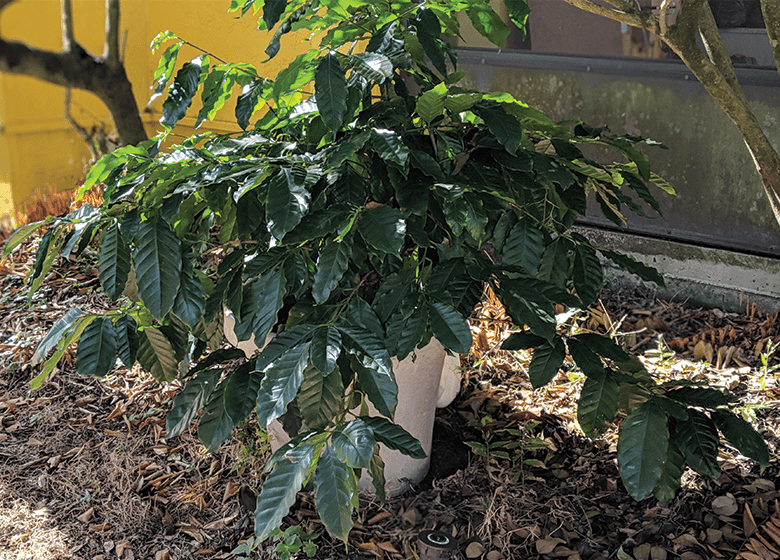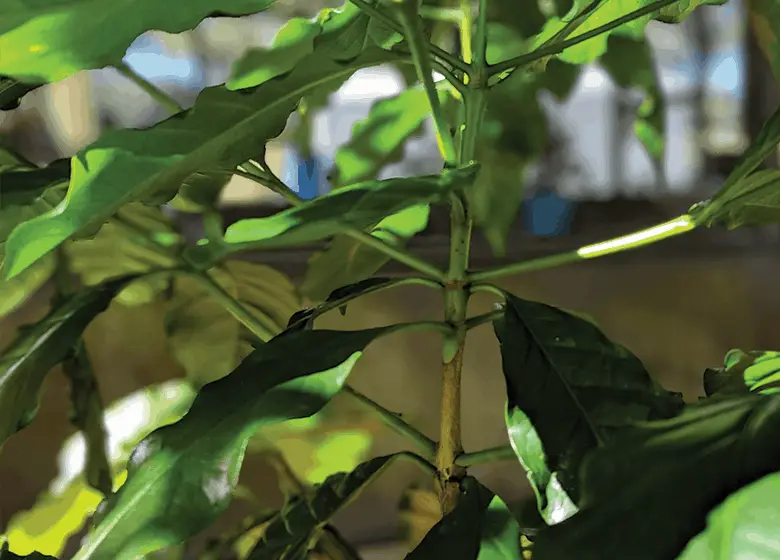Growing coffee in Florida from your home sounds like a fantastic idea, right? I mean who doesn’t love a good cup of coffee?
But, can you grow coffee in Florida? Yes, You can grow coffee in Florida.
Coffee loves an acid soil and plenty of water, coffee is also normally grown at high altitudes, which is something that we obviously don’t have here in Florida. Does this mean that we can’t get a harvest?
No. We can get a harvest. The flavor just won’t be as good as it could be.
Read on to find out what gives coffee it’s flavor and see how we can best grow it in Florida.
Native Florida Coffee
There is actually a “coffee” that grows wild in the southern parts of Florida. It’s fancy scientific name is Psychotria nervosa. It’s in the same family as the coffee we drink everyday. The plants themselves also look a lot like twins. They both have large, dark green, glossy leaves and little jasmine like flowers that turn into red berries with two little seeds in them.
It apparently doesn’t taste the best and lacks caffeine…
So what’s the point of growing this thing if it doesn’t taste good or get me amped?
Florida wild coffee is a nice addition to the landscape because it looks beautiful, doesn’t require much care once established, the flowers bring in butterflies and the birds love to eat the seeds. They can grow up to be about 5 feet tall and they act as a good privacy screen.
Which Variety Of Coffee Should I Grow?

The coffee that you drank today is probably from the Arabica variety of the plant. There are really just two common types of coffee that are grown around the world for drinking purposes.
- Arabica
- Robusta
Arabica is the best-tasting variety right now. But, the boundaries are being pushed on that with a small group of robusta growers at the Taza Dorada cupping competition.
Coffee Robusta is a much tougher plant. It is more disease resistant and produces a larger crop. However the taste is much more bold. Some people enjoy the bold taste that robusta offers.
I’m not one of those people.
Robusta also offers more
So, Robusta does offer really nice benefits but I would rather grow an arabica variety of the plant so that I can actually enjoy the taste of my coffee. Sure, it will be a little extra work but I think it will be worth it.
There is some exciting coffee research in the works though that will be breeding the best qualities of both plants.
Where In Florida Can I Grow Coffee?
The best location for my coffee plant is on the east side of my house underneath a few ligustrum shrubs that I have.
This spot lets my coffee plant get lots of early morning sun and then dappled shade in the afternoon. It seems to love this area.
I have my plant in a large pot because on cold winter nights I do have to bring it in for protection.
David the good, said that he put his coffee plant on the south side of his house and it survived a north Florida winter.

The reason he said? heat retention from his home. I had no idea that being placed right next to the south side of a home would make such a big difference!
The ideal temperature for coffee to grow is between 59 -75 degrees. We are usually way hotter than that. Temperatures above 86 degrees and below 41 degrees will slow down growth.
anything below freezing and that’s it, coffee is done for.
So, even though we aren’t in the ideal conditions for coffee we can still create a microclimate for the plant in which it can grow decently.
Placing your plant in a space of your house that gets plenty of morning light and is shaded in the afternoon keeps the plants area slightly cooler.
Coffee grows at a much higher altitude.
What Kind Of Soil Does Coffee Like?
Coffee is best grown on the slopes of mountains and volcanoes. This soil is usually highly acidic with lots of organic matter. This composition provides great air and water flow, plenty of things for roots to grab on to, and great water retention.
This is something that our Florida soil doesn’t really offer, unless you have been building your soil for some years. This is why I have my coffee plant in a pot. I can build the best soil for it.
Coffee prefers a soil ph that is between 6-6.5.
To achieve all of these things that coffee loves I use a mix that’s slightly different than my normal mix.
- 40% peat moss
- 40% compost
- 20% perlite
- 1 bag of crushed lava rocks (Thanks MIgardener for this tip!)
- Worm castings
- Fungi additive
This gives coffee plenty of organic matter to grab on too while also give the soil plenty of airflow and drainage. The crushed lave rock adds nutrients that coffee naturally thrives on.
I can’t find any lava rocks that are already crushed so I’ve had to do it myself. I just take a bag I don’t care about, put some rocks in there and take a rubber mallet to crush them.
I love adding worm castings to all my soil, plants seem to love the stuff. and I introduce some fungi to the dirt to create a web of nutrient
How To Fertilize Coffee
Fertilizers are usually broken down by three numbers. These are the Nitrogen, phosphorus, and potassium values that the fertilizer contains.
The plant uses nitrogen for green leafy growth. It uses phosphorus for fruit production and potassium for overall health.
Coffee plants don’t produce fruit for the first few years of their life. So you don’t really need a fertilizer with a lot of phosphorus(The middle number) until it’s a few years old.
I’ve always used a fertilizer for citrus plants. It’s called Citrus-tone(Check price on Amazon). It’s rated as a 5-2-6 fertilizer.
As your plant ages, you can fertilizer with something that has a higher phosphorus value to increase your harvest.
You should apply your fertilizer as our weather warms up, late spring early summer.
When to harvest coffee in Florida
Coffee should bloom during the summer months. It will boom clusters of small white flowers during this time. It will take a few months for your coffee to ripen enough to be picked.
Once the flowers produce berries, they will start off green, turning into a deep red when they are red to be picked. This is usually during the months of fall.
Not all of the little coffee cherries will be ready to be picked at the same time. Only pick the deep red colored ones.
How do I Process Coffee?
The easiest way to process coffee at home is to wash it. There are a few other ways to process coffee like, naturally process or honey processed.
But those have higher chances of ruining your coffee if you don’t know what you’re doing.
A washed process coffee involves peeling your coffee cherries. When you break open the red berry iyou will see two seeds in there. Packed face to face.
Take all of those out and throw them in a bucket of water for about two days.
After this, rinse the coffee beans thoroughly and lay out flat to dry. This should also take about two days and its good if you can move the beans around a little bit every few hours. This helps them dry evenly.
Growing Coffee In Florida
- Yes, we can grow coffee in Florida. Southern Florida will have the easiest time growing coffee.
- Coffee prefers a stable climate around 75 degrees. We can’t be perfect but we can create a micro climate with morning sun and mid-day shade that coffee can grow in.
- Coffee likes a slightly acidic soil with lots of organic matter. Make your own potting mix with peat moss, compost, perlite, crushed lava rock, worm castings and fungi.
- Coffee doesn’t make fruit the first few years of it’s life. Fertilize with a citrus fertilizer, something like a 5-2-6.
- Coffee blooms in summer and is ready for harvest during the fall. Only pick red cherries.
